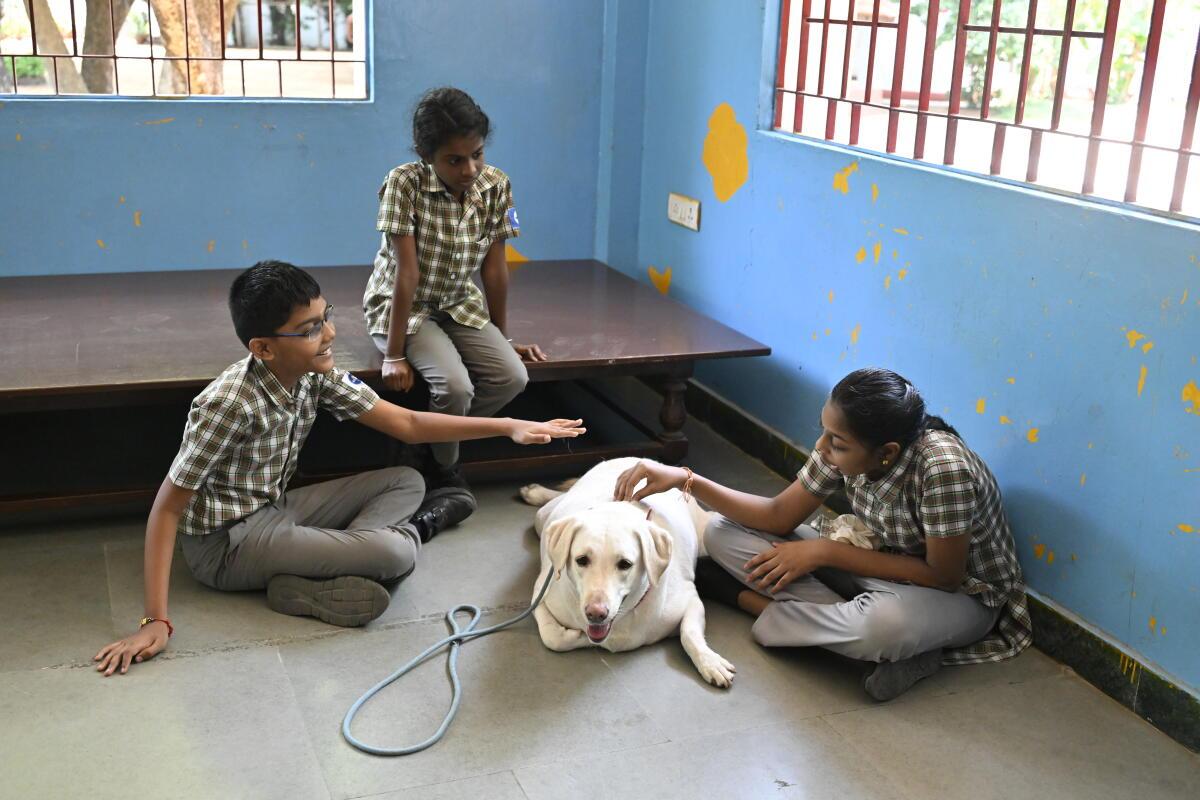Meet Rinku, also known as Dr. Dog, who works with children at Saraswati Kendra, a school for children with special needs, in Chennai.
These children face challenges such as learning disabilities, autism, and dyslexia, and the school uses animal-assisted therapy to help them develop social and behavioral skills.
When Rinku, who has been the Dr. Dog for two years now, walks into the room, the kids light up with excitement. The ‘doctor’ comes in, looks at everyone, goes around sniffing and wagging her tail. “What does Rinku like?” a psychologist asks. “Biscuit,” one student replies. Then comes the follow-up: “But are biscuits healthy?” “No,” the children answer.
Through moments like this, the children are gently encouraged to speak, learn lessons, communicate, and build social skills — all with Rinku as the medium.
Dr. Dog, Rinku
| Photo Credit:
AKHILA EASWARAN
How it all began
“I first read about pet therapy being done in the United States. But that involved using horses. Where could we get horses in Chennai? So I tried it with my own dog, Cleo. And then Sachin, my dachshund,” says Nanditha Krishna, president, C.P. Ramaswami Aiyar Foundation, and founder of Saraswati Kendra.
One of the first children to try this therapy was a nine-year-old with autism who hardly spoke. One day, he surprised everyone by saying, “Sachin, I had upma for breakfast. What did you have?” For the educators, this was a huge breakthrough, says Ms. Krishna.
According to Ms. Krishna, Saraswati Kendra was the first place in India to introduce pet therapy, back in 1996. A major turning point came in 2001, when Jill Robinson, an animal welfare activist and founder of Animals Asia Foundation, a non-profit working in animal welfare, visited. She taught them how to assess dogs for therapy and how to interact with them. Ms. Krishna learned these techniques and has been using animal-assisted therapy at the school ever since.
Screening the ‘doctors’
Dr. Dog comes in for 40 minutes a day. Each session has one or two students.
All the therapy dogs are rescues adopted by Ms. Krishna. She personally assesses them to make sure they are friendly and calm, traits that are important for working with children. “The dogs must be at least two years old,” she says. Only sterilised dogs become “doctors.”
Over the years, many dogs have taken on the role of Dr. Dog.

Jill Robinson, an animal welfare activist visited the school in 2001 and taught the authorities how to assess dogs for therapy and how to interact with them.
The therapy offered
So, how does Dr. Dog help the children?
Psychologists at the school explain that the dog is used as a bridge to teach and encourage children to open up. There’s no special training given to the dogs, other than thoroughly ensuring that they are healthy and comfortable being around children.
“For children on the spectrum who suddenly stop speaking, we use Dr. Dog to gently encourage them to talk, like saying, ‘Dr. Dog had curd rice. What did you have?’” says S. Niraja, the chief psychologist, adding that dogs are amazing at picking up cues, even before someone gives a command. “They develop a soul connection.”
Children are chosen for therapy based on their needs and ability to bond with the dog. Over time, they become more open, and some even develop a sense of responsibility for the dog. “The Dr. Dog makes them feel important, like someone needs them in their life,” she says. For children with ADHD who tend to run around, the therapists tell them the dog is tired and wants to sit. So the children come and sit beside the dog, calming down in the process.
Ms. Niraja explains that there’s also a gradual weaning process when it’s time to wrap up therapy. It begins by gently asking the child if they’re okay “sharing” Dr. Dog with another student. Once they agree, a new child is introduced. “We make sure the first child still feels important,” she says. They are encouraged to talk to each other, and over time, as the child becomes more comfortable, the therapy is gradually concluded.
During sessions, the children are asked to write about Rinku. On Thursday, one child wrote, “Rinku is a happy dog.” Another wrote, “Rinku best friend is Maya.” Everyone was surprised. Maya is another dog at the campus, and the child had noticed them spending time together. The therapists were pleasantly surprised at the keen observation by the student.
Tulasi, the previous Dr. Dog at Saraswati Kendra
| Photo Credit:
AKHILA EASWARAN
Sudeep Kumar Kapalavai, senior consultant at the paediatric intensive care unit of the Kanchi Kamakoti Childs Trust Hospital in Chennai, who was part of a pilot project to use pet therapy to facilitate early mobilisation of patients, said that dogs can help with emotional stability. “Pet therapy, to an extent, can be a mood stabiliser. In fact, we think, it can also help in adult ICU,” he said.
After each session at Saraswati Kendra, Rinku often has a little fan club waiting outside with kids eager to pet her, say hi, or spend a moment with their favourite four-legged doctor.
Published – April 18, 2025 11:41 pm IST











Leave a Reply